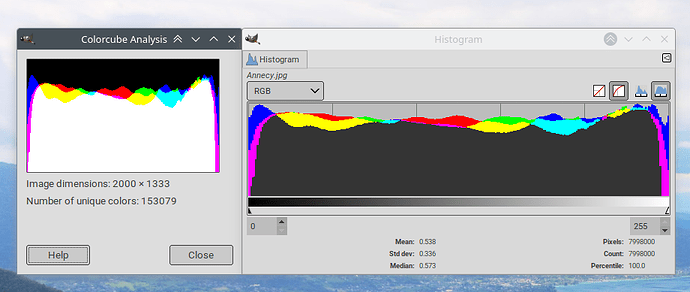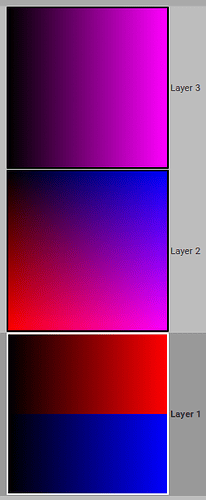It is not “hidden” because even the source code isn’t there. Is there another tool that reports the number of distinct colors in an image? This is a fairly useful metric…
Looks like it was removed by plug-ins: remove color-cube-analyze without replacement (496b5ab9) · Commits · GNOME / GIMP · GitLab
I’ll look and see if there’s another way to get that info.
Technically, you can try to import a palette firm the image using an insanely huge number of colors. But that would be a bit wasteful.
Looking at the commit message, it looks the main removal reason was that we saw no usage for this plug-in.
Would you mind opening a bug report (in gimp-ux repo) with info on why it was useful for you and how you were using it? (preferably real scenarios like “I want to do this so I used this plug-in this and that way”, not just “reports the number of distinct colors in an image […] is a fairly useful metric…” which is a bit vague).
Also isn’t the Histogram dockable providing some similar feature? (note that I have no idea what exactly the Colorcube plug-in was doing) Or maybe it is missing some parts of the plug-in feature, but maybe it would be worth adding them to Histogram core feature rather than as a separate plug-in (if really useful generically)?
Note that my stance right now on core plug-ins is that we should not add every possible plug-in out there for every possible use case. This was working fine 20 years ago when creators making GIMP plug-ins were still limited, but we can’t add 100 default plug-ins now (if we were to accept everything, because it is useful to 1 person somewhere).
Nevertheless for things which are really useful generically to a lot of people and therefore make sense in an image editor/creator, adding a plug-in makes sense. Or even if it looks like it’s really a must-have for any sane image editor/creator, making it a core function may be even better. For the rest, my plans are to (hopefully soon enough) provide an extension platform where people will be able to upload their plug-ins and others will be able to download whatever they need, which will manage updates, uninstallation, enabling/disabling, etc. ![]()
All this being said, a discussion on this specific feature in gimp-ux would help make a decision in which category such plug-in would go in.
@Jehan This is the output of the plug-in on 2.10 - it’s a pretty simple plug-in:

I think the missing feature is the “Number of unique colors” display. It feels like something we could add to the histogram editor to solve the problem.
I think the missing feature is the “Number of unique colors” display. It feels like something we could add to the histogram editor to solve the problem.
It is indeed the thing I use. The rest of the output is just a poor man’s Histogram dialog (can’t be resized, and only gamma+log):
But the histogram alone doesn’t tell everything, the three layers below have the same histogram:
Btw, in your example; 17444 colors in a 6Mpix image is pretty low. Is that a CGI?
PS: plug-in-ccanalyze can be used to return the number of colors in an image, so if this function is transferred to the histogram, some equivalent to this could be kept. And while we are dabbling with statistics, something that isn’t very easy to obtain currently is the average color of the selection. The average as returned by the histogram plugin is the direct average of the values (and we have to do this for each channel). But in a 8bpc image the average color should be the gamma encoding of the average if the linear values (so for instance a checkerboard pattern should return 186 and not 127.5).
Ah, plug-in-ccanalyze is the removed Colorcube Analysis plug-in, just run non-interactively. ![]()
I’ll try to port it and see where the function would best fit - it seems useful.
The image was a JPEG of the sea as the sun was setting, so that probably explains it.
This topic was automatically closed 45 days after the last reply. New replies are no longer allowed.

